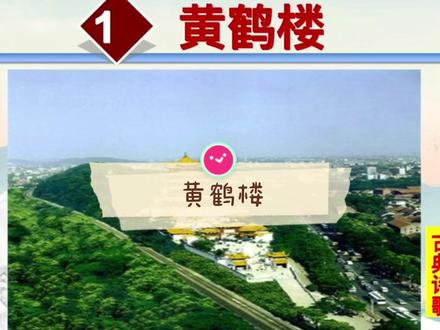黄鹤楼用说明文的方法
yellow crane tower stands atop snake mountain in wuhan city, hubei province legend goes that a taroist priest painted a dancing yellow crane on the wall of shin's tavern, which greatly boosted the business here a decade later the priest revisited the tavern and called down the crane by playing the flute and flew away on its back should then built a tower here and named it after the yellow crane however, textual research testifies that the tower gets this name as it perches on yellow crane mountain yellow crane tower was first built as a watch tower in 223ad during the three kingdom period after the war, the tower lost its military value and gradually blossomed into a must see spot a large number of literarty from various dynasties have visited here leaving an abundance of famous poems such as the yellow crane tower written by the poet of the tang dynasty however due to the countless wars and fires the yellow crane tower was demolished and rebuilt many times in history it is in the qing dynasty alone that three serious fires occurred here the last tower of the qing dynasty was constructed in 1868 ad and was reduced to ashes in 1884 ad since then it has not been repaired for nearly a hundred years what we see today is the modern yellow crane tower which was started in 1981 and completed in 1985 the building is based on the prototype of tonji tower in the qing dynasty, it is five storied with a total height of 51.4m and the floorage of 32019 square meters the interior of yellow crane tower is supported by 72 pillars with 60 warping angles extending outward and the roof is covered with more than one hundred thousand yellow glazed tiles the entire building of yellow crane tower has a unique national style which radiates the spirit temperament and charm of chinese traditional culture yellow crane tower belongs to the three great pavilions in the south of the yangtze river in china besides yang tower in hunan province and princeton pavilion in jiangxi province it is now a national 5 a tourist attraction。
粉丝316获赞3298
相关视频
 06:51查看AI文稿AI文稿
06:51查看AI文稿AI文稿大家好,今天我们来学习古诗黄鹤楼。崔浩 黄鹤楼是在武昌蛇山的,黄鹤楼有天下独景的声誉,与湖南岳阳楼、江西滕王阁并称为江南三大名楼。黄鹤楼濒临万里长江,雄聚蛇山之巅, 挺拔独秀,辉煌瑰丽,很自然就成了名传四海的游览胜地。历代名士都先后到这里游乐,吟诗作赋。 黄鹤楼也有这样一个传说,我们来一起看一看。说古代武昌蛇山上有一座酒楼,老板姓心,此人很慷慨。某日有道士来饮酒,新老板不收起酒钱。道士为了感谢新老板的盛, 临别时用橘子皮在墙上画了一只仙鹤,谁知这仙鹤在客人来饮酒时会跳舞助兴,从此酒店生意红火,新老板也因此发了财。 十年后,道士重来,歌笛一曲,只见白云朵朵空中来,仙鹤随之起舞,道士也齐鹤而去。新老板为纪念此事,就在蛇山上心宫动土,见高楼一幢,取名黄鹤楼。 那当然还有这样一个传说,说有一位名叫费医的人,在黄鹤山中修炼成仙,然后称黄鹤升天。后来人们为纪念他,便在这黄鹤山上建造了一座黄鹤楼。我们一起先来看一看。学习目标, 理解诗歌的主要内容。二、体会诗歌的思想感情。三、流利流畅的背诵诗歌。首先我们了解一下作者,他是开封人士崔浩, 唐玄宗开元十一年,公元七二三年中进士。他才思敏捷,长于写诗,是圣唐诗人。旧唐书文苑传中把他和王昌岭、高氏、孟浩然并提,但是他宦海浮沉,终不得志。 我们来看一看黄鹤楼这一球式的翻译, 传说仙人已成黄鹤去,此地只留下了空空的黄鹤楼,这就是手连。仙人已成黄鹤去,此地空余黄鹤。 黄鹤一去不复返,白云千载空悠悠。他的意思就是黄鹤飞去后不会再回来了,而千百年来,白云却依旧悠然自得的飘来飘去。 灯笼隔江相望,海洋的树木清晰可见,鹦鹉洲上的芳春草长得茂盛喜人晴川莅临汉阳树,芳草栖息鹦鹉洲的意思就是这个 日暮相关何处是,烟波将上使人愁。意思就是,可是日进黄昏,积木远眺,我的故乡在哪呢?也是长江上面浩渺的烟波,真使人发愁啊。 我们来想一想,诗中借用仙人故事的诗句是哪一句呢?引用神话传说的 这样的一个表现,是为了要表现做着什么样的情感呢?其实就是昔人已乘黄鹤去,此地空于黄鹤楼。这一句是,那我们看一看,从眼前的黄鹤楼长发了联想想象昔日先人乘黄鹤楼过此,如今人去楼空,令人畅往。 借传说落笔,感叹物是人非,他也为黄鹤楼蒙上了一层神秘的色彩,传达出诗人内心的孤寂与苦闷。 我们接下来再来看此地空于黄鹤楼和白云千载空悠悠中的空字,他们的诗意意境是不一样的,我们可以进行赏悉。首先此地空于黄鹤楼,这个空是只只有的意思,此地只有黄鹤楼,重在斜景。 而第二个空是有空空的空荡荡之意。这个空字传达的是诗人因漂泊在外,内心失落惆怅,重在抒情。 包括景联,描绘了一一幅怎样的画面呢?景川丽丽汉阳树,芳草聚集鹦鹉洲也是在写景名利的阳光下,从黄鹤楼遥望对岸汉阳的绿树眼映看上去分外清晰。鹦鹉洲上芳草葱笼,生气盎然。 伟林日暮相关,何处是,烟波江上使人愁。不应该这么上心, 就是他,我们可以先把他的意思解释一下。太阳快下山了,在黄鹤楼上哪里能望到故乡?只觉得眼前的江水滚滚,烟波浩渺,使人更上思乡之愁。 本剧借景抒情,用烟波浩渺的长江烘托筹思,抒发了漂泊思乡之情。 我们全身以仇字书篇有什么作用? 以筹字书篇其实是提到了点题点主指的作用,以筹字作节,点出了全篇的主指,准确的表达了日暮时分诗人登临黄鹤楼的心情,同时又和开篇的意境相照应, 从而以起伏辗转的文笔表现了缠绵的乡愁。我们再来看一看,这就是的主旨。黄鹤楼主要描写的是人登临黄鹤楼所见到的情景,通过平调古迹,抒发了思念家乡的 酬勤。吊鼓槐香。大家看这一首诗,他的艺术特色,他虚实相应,意境开阔,情景交融。手帘和汉联从传说入笔,讲述昔人黄鹤,这是须写,给人以无限缥缈的感受,其实苍茫 而井连和尾连,转而写楼上的所见所闻,这是实写,很自然的引起世人浓浓的乡愁。伟连写燕波上的日暮归四归, 正好与世开片的缥缈相一致,使得诗歌一气呵成,已经开阔,让读者不禁心入其境,畅然生请。 那我们看一下版图设计。黄鹤楼的手帘是神秘传说,起笔叙事汉联岁月,岁月亦是 在议论景莲写字作者灯笼所见在写景,而玮莲在抒情。浓浓的乡愁,调骨怀香之情,同学们,再见!
78乐天英语笔记
猜你喜欢
最新视频
- 270蔡儿


















